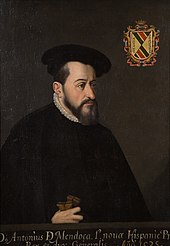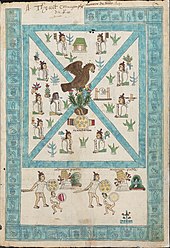Antonio de Mendoza
Don Antonio de Mendoza y Pacheco (* approx. 1490 in Alcalá la Real ; † July 21, 1552 in Lima ) was 2nd Marqués of Mondéjar and first Viceroy of New Spain from 1535 to 1550 and from September 23, 1551 to 21. July 1552 second viceroy of Peru .
family
Antonio de Mendoza was the son of the first Marquis de Mondéjar Don Íñigo López de Mendoza y Quiñones (1440-1515) and his second wife Francisca Pacheco Portocarrero (* approx. 1440), a daughter of Juan Pacheco and María Portocarrero Enríquez, VI señora de Moguer y Villanueva del Fresno. He came from high-ranking noble families , whose members often embarked on military careers or went into civil service. He himself was married to Catalina de Vargas, daughter of Francisco de Vargas, the counselor (contador mayor) of the Catholic Kings ; with her he had three children: Íñigo, Francisca and Francisco.
Appointment as Viceroy of New Spain
Mendoza was not Charles V's first choice for the newly created office of Viceroy of New Spain: Don Antonio only accepted the office after three high nobles had refused the appointment. He had previously worked as an ambassador to Hungary , Italy and Germany and proved to be a smart administrator. His task was difficult in that it required him to rule in the name of Charles V without making Hernán Cortés an enemy. The fact that Cortés had only been appointed by the emperor as military commander-in-chief and captain-general of New Spain as well as Marqués del Valle de Oaxaca represented a demotion for him, who had conquered the Aztec empire . So Cortés tried in vain to end his life with Charles V. to enforce his appointment as governor or even viceroy of New Spain.
Expeditions
Mendoza and Cortés have long been competitors. Both wanted to find and conquer the rich cities of the north, which Cabeza de Vaca had told about when he returned from Florida in 1536 . Its reports were spread very falsely and aroused great expectations. The legend of the Seven Golden Cities of Cibola was born .
Cortés tried the sea route along the Mexican west coast. In 1539, Mendoza sent the Franciscan Marcos de Niza to the north by land. He was supposed to find the cities and later show an expedition the way there. After Marcos de Niza returned, Mendoza sent his friend Francisco Vásquez de Coronado (1540–1542) to the north with an army. He should incorporate the seven golden cities of Cibola into the realm of the Spaniards.
After Coronado's departure, an uprising ( Mixtón War ) broke out in Nueva Galicia ( New Galicia ) . After several failures by his captains, Antonio de Mendoza had to take care of the military solution to the problem himself. With 450 Spaniards and around 30,000 allied Aztecs and Tlaxcalteks , he put down the uprising in 1541.
Mendoza invested a lot of money in the expedition. But the expedition to the north turned out to be a financial fiasco, as the Spaniards could not find gold and the cities of the Pueblo Indians were so poor and remote that it was not worth holding.
In the years (1542–1543) the viceroy Juan Rodríguez sent Cabrillo along the Pacific coast northwards on another voyage of discovery. In addition, he commissioned the expedition of Ruy López de Villalobos to the Philippines in 1542–43.
education
Don Antonio de Mendoza and Bishop Juan de Zumárraga did a lot for education in Mexico. They set up two universities: the Colegio de Santa Cruz in Tlatelolco (1536) and the Universidad Nacional Autónoma de México (September 21, 1551), where the University of Salamanca served as a model. These universities, along with the University of Lima, were the first in America. The Spanish language began to spread in Mesoamerica through the missionaries and their educational institutions . On his orders, the first printing press of the New World was put into operation in Mexico in 1539 by the printer Juan Pablos (Giovanni Paoli).
The Codex Mendoza was commissioned by him and named after him.
Power and impotence of the crown
On March 25, 1544 Viceroy Mendoza published the Leyes Nuevas , which the reformer Frey Bartolomé de las Casas had suggested. They were supposed to ease the plight of the Indians under the encomienda system. Mendoza saw very well that he was unable to immediately enforce the laws against the will of the opposition of the Encomenderos. That is why he only introduced them in stages. When he received news from the viceroyalty of Peru that reported a civil war there after similar reforms, he had the laws repealed.
Mendoza did a lot to improve the lot of the locals and convened a church conference to do this in 1547. However, he also showed severity against all who opposed Spanish supremacy. The following year he suppressed a Zapotec uprising .
During his reign the sovereignty of the crown was enforced throughout New Spain and the power of the first conquistadors was broken. As a capable and honest viceroy, Mendoza ruled with justice, efficiency, and compassion. He promoted the construction of hospitals and schools and campaigned for improvements in agriculture and mining. Much has been done under his government to achieve stability and peace in New Spain. In 1536 he started minting silver and copper coins. On May 18, 1541, Don Antonio founded the city of Valladolid (now Morelia in Michoacán ).
Viceroy and death in Peru
On July 4, 1549, Emperor Charles V appointed Antonio de Mendoza Viceroy of Peru in Brussels . Although his health was already in poor health, he accepted the change. He traveled overland from Mexico to Panama and from there by ship to Peru. He arrived there on November 25, 1550 and began work. However, he soon fell ill and died in 1552 after only ten months of reign. He was buried in Lima Cathedral. Luis de Velasco succeeded him as Viceroy of New Spain.
Web links
- Biography (spanish)
- mexconnect (english)
- Codex Mendoza
Individual evidence
- ↑ Klaus-Jörg Ruhl, Laura Ibarra García: Small History of Mexico, Publisher: CH Beck, p. 105.
- ↑ DNB 97950905x / 34
- ↑ The Gutenbergs of Latin America . ( Memento from November 1, 2006 in the Internet Archive ) (PDF) Heidelberg - HN 255
- ↑ Leyes Nuevas . laconquista.de
- ^ The first and the best: Viceroy Antonio de Mendoza . mexconnect.com
| predecessor | Office | successor |
|---|---|---|
| - |
Viceroy of New Spain 1530–1550 |
Luis de Velasco |
| predecessor | Office | successor |
|---|---|---|
| Pedro de la Gasca |
Viceroy of Peru 1550–1552 |
Melchor Bravo de Saravia |
| personal data | |
|---|---|
| SURNAME | Mendoza, Antonio de |
| ALTERNATIVE NAMES | Tendilla, Don Antonio de Mendoza y Pacheco Count of (full name) |
| BRIEF DESCRIPTION | Spanish nobleman, first viceroy of New Spain (1535–1550) |
| DATE OF BIRTH | around 1490 |
| PLACE OF BIRTH | Alcalá la Real |
| DATE OF DEATH | July 21, 1552 |
| Place of death | Lima |


